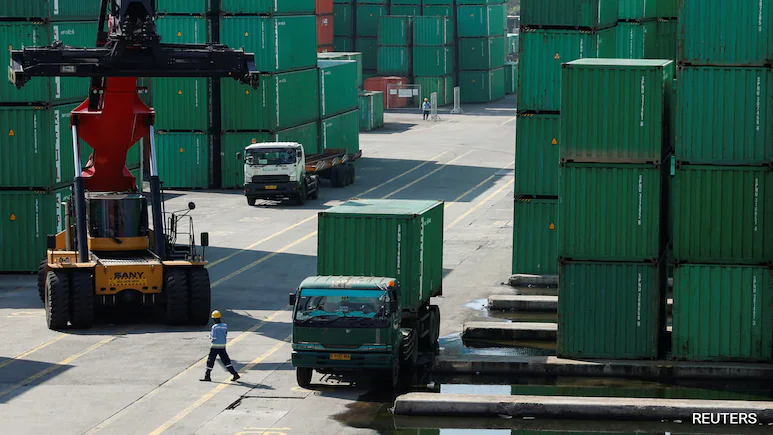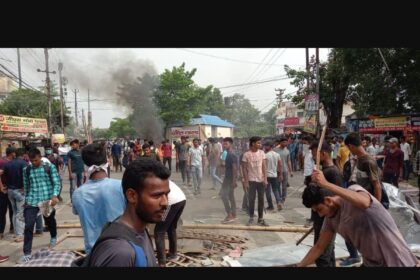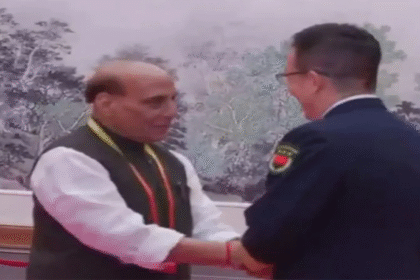Setting the Stage — Trade Wars, Tariff Decisions, and the Indian Economy
On July 31, 2025, headlines around the world echoed with one bold decision — former U.S. President Donald Trump, currently seeking re-election, announced a sweeping 25% tariff on a fresh list of imports, many of which include Indian goods. This decision has sent ripples across global financial markets, particularly in emerging economies like India, which are heavily dependent on exports to the United States.
The move marks a stark revival of Trump’s signature economic policy: “America First”, focused on reviving domestic manufacturing, curbing trade deficits, and reducing dependency on foreign imports. However, in an era of interlinked global supply chains, this aggressive stance toward tariffs isn’t without consequence — especially for a country like India.
This long-form article is an in-depth investigation into how Trump’s 25% tariff move could impact Indian markets, industries, geopolitical ties, and ultimately, the Indian consumer. Presented in multiple parts, it draws on expert analysis, economic history, market data, and policy trends.
🔍 Understanding Tariffs in Context
Before diving into impacts, it’s essential to understand what tariffs are and how they function in modern international trade.
Tariffs are taxes imposed by one country on goods and services imported from another. In theory, tariffs protect domestic industries by making imported goods more expensive, thus giving a competitive edge to local producers. However, in practice, they can spark trade wars, distort market efficiency, raise consumer prices, and reduce global economic growth.
The U.S., under Trump’s first term (2016–2020), adopted several protectionist policies, imposing tariffs on China, the EU, and even allies like Canada and Mexico. India, though less severely hit, was not spared. The revocation of India’s Generalized System of Preferences (GSP) in 2019 had already led to friction between New Delhi and Washington.
The latest tariff hike in 2025 revisits this turbulent trajectory — but with deeper stakes.
🌐 U.S.-India Trade Landscape — A Brief Overview
India is among the top 10 trade partners of the United States. In 2024, bilateral trade between the two countries stood at $192 billion, with Indian exports accounting for a significant portion of that value.
Key export categories from India to the U.S. include:
- Pharmaceuticals
- Textiles and garments
- Gems and jewelry
- IT services and software
- Steel and aluminum components
- Automotive parts and accessories
A blanket 25% tariff across major Indian exports could erode the cost advantage Indian companies have long enjoyed. In industries like pharma and textiles, where India competes with nations like Bangladesh, Vietnam, and China, even small cost shifts can mean loss of market share.
Moreover, such a tariff comes at a time when India is trying to position itself as a global manufacturing hub under its “Make in India” campaign — a position that depends heavily on access to foreign markets like the U.S.
📊 First-Wave Reaction — The Indian Stock Market Responds
Markets hate uncertainty. On the day of the tariff announcement, the Nifty 50 dropped over 360 points, while the Sensex closed down nearly 650 points, wiping out billions in market capitalization.
Sectors most impacted in early trading included:
- Textiles and Apparel: Brands and exporters like Arvind, Welspun, and Raymond saw dips ranging from 3–8%.
- Pharmaceuticals: Companies like Sun Pharma, Dr. Reddy’s, and Lupin took modest hits due to investor fears of price erosion in U.S. generics.
- Automobile and Ancillaries: Motherson Sumi and Bharat Forge, who rely heavily on U.S. demand, dipped nearly 5%.
The Indian Rupee also depreciated to ₹84.92/USD, the weakest it had been in six months, as foreign investors pulled out capital amid uncertainty.
Foreign Institutional Investors (FIIs), typically sensitive to U.S. policy moves, were net sellers to the tune of ₹3,450 crore that week alone.
📦 Sectoral Breakdown — Who Gets Hit First?
Let’s take a closer look at how key Indian sectors are positioned in this brewing tariff storm:
🏭 Textiles and Apparel
India’s garments sector exports $9–10 billion worth of apparel to the U.S. annually. The industry, already battling competition from Bangladesh and Vietnam (who enjoy zero-tariff access to the U.S. under trade agreements), faces an existential threat.
A 25% tariff on cotton garments, synthetic wear, and home textiles would either:
- Force Indian exporters to absorb costs, reducing their already razor-thin profit margins, or
- Pass costs to buyers, which could lead to order cancellations or loss of contracts.
This is particularly damaging for micro and small textile manufacturers in Gujarat, Tamil Nadu, and Uttar Pradesh who survive on volume exports.
💊 Pharmaceuticals
The U.S. is the largest market for Indian generic drugs. India exports nearly 40% of its pharma output to the U.S., valued at over $6.5 billion annually.
While drugs often receive special treatment in trade agreements due to public health implications, the inclusion of non-patented formulations and nutraceuticals in the tariff list could dent this revenue stream. Additionally, companies may have to renegotiate contracts at lower margins.
🏗️ Auto Components
India’s auto component exports to the U.S. have grown steadily — from $1.2 billion in 2017 to over $2.5 billion in 2024. The 25% tariff will have a cascading effect on cost structures for Indian component manufacturers.
Major cities affected: Pune, Chennai, Gurugram, and Coimbatore — all hubs of automobile engineering.
📉 Domino Effect — The Bigger Economic Picture
The tariff effect is not confined to trade. It radiates through various layers of the economy:
- Jobs: Export-heavy sectors like textiles, auto, and pharma employ millions. Job cuts in response to falling orders are a real threat.
- Currency: The weakening rupee may further inflate India’s import bill, particularly crude oil.
- Inflation: Supply disruptions could lead to higher domestic prices.
- Current Account Deficit: A fall in exports and rising imports could widen India’s CAD, making it harder to manage external debt.
In the long term, persistent U.S. tariffs may force India to rethink its trade partnerships, diversify export destinations, and reduce dependency on Western economies.
🛠️ Government’s Initial Response
India’s Commerce Ministry termed the tariffs “unilateral, regressive, and harmful to global trade recovery.” In a press conference, Commerce Secretary Anurag Sharma hinted at possible retaliatory tariffs on select American goods, including agricultural imports, motorcycles, and whiskey.
The Finance Ministry is also reportedly working on a stimulus package for export-facing MSMEs (Micro, Small and Medium Enterprises) to help soften the blow.
However, with general elections around the corner in both nations, the room for high-level trade negotiations remains limited. What emerges instead is a geopolitical standoff, with the WTO expected to become a key arena of contest.
Trump’s 25% tariff decision is not just a fiscal policy shift — it’s a signal of a deeper economic nationalism that could reshape India-U.S. trade dynamics. As Indian industries brace for a wave of challenges — from shrinking margins to potential layoffs — policymakers and corporate leaders are now walking a tightrope between damage control and strategic repositioning.
In the next part, we’ll explore how this trade shock interacts with:
- Domestic political pressures in India
- U.S. electoral politics and campaign strategy
- Global supply chain realignments
- Sectoral deep dives: IT, gems, agriculture
As the dust begins to settle on the initial market reaction to Trump’s 25% tariff decision, a broader and more intricate layer emerges — the political ramifications. This part of the article delves into the geopolitical dynamics, domestic pressures on both governments, election strategies, and the way trade policy is increasingly being used as a political weapon.
While economic fallout is real and immediate, the long-term effects of these tariffs will be determined by how New Delhi and Washington respond diplomatically, legislatively, and strategically.
🗳️ The Political Theater — Trump’s Return and America’s Protectionist Pivot
To understand this policy shift, we must dissect the political context behind it. Donald Trump’s re-entry into U.S. presidential politics in 2025 has been characterized by a strong nationalist tone, where tariff threats are not just economic levers — they are campaign tools.
🔻 Trump’s Messaging Strategy
Trump’s narrative is rooted in the belief that “unfair foreign competition” has hollowed out American manufacturing. His core supporters — particularly in Rust Belt states like Michigan, Ohio, and Pennsylvania — resonate with this message. Imposing tariffs on imports from nations like India helps Trump project strength, assert independence from global institutions, and promise economic protection to American workers.
“We are bringing jobs back. We are ending dependency. And we will stop being taken for granted,” Trump declared in his Ohio rally on July 28, just days before the tariff order.
This rhetoric serves multiple purposes:
- It distracts from domestic economic challenges (like inflation and wage stagnation).
- It pins blame on foreign nations, including allies.
- It signals seriousness to business lobbies and trade hawks.
India, unfortunately, becomes collateral in this political maneuver.
India’s Balancing Act — Diplomatic Calculations Amid Economic Headwinds
From India’s side, the 25% tariff comes at a crucial moment. Prime Minister Narendra Modi, eyeing his third consecutive term, is navigating a tightrope between economic growth, employment generation, and global diplomatic relations.
While India has carefully cultivated stronger strategic ties with the U.S. over the past decade — in defense, technology, and education — these economic shocks threaten to strain the partnership.
🧭 Key Diplomatic Dilemmas for India:
- Retaliation vs. Restraint:
India has historically avoided direct tariff retaliation against the U.S., preferring backchannel diplomacy. However, with domestic industries lobbying hard, the government may be forced to respond more aggressively this time. - Domestic Industrial Pressure:
Exporters’ associations, especially from the textile, pharma, and auto sectors, have already demanded duty drawback extensions, currency support, and alternative trade routes to offset losses. - Global Perception:
India is positioning itself as a neutral, reliable, rules-based trading partner — especially for companies shifting out of China. Overreacting could damage this image. - WTO Engagement:
India may pursue a case against the U.S. at the World Trade Organization, but that route is slow and often symbolic rather than effective.
🤝 U.S.-India Trade Talks — The Fractured Framework
The U.S.-India trade relationship has seen fits and starts over the past decade. Multiple rounds of negotiations on Free Trade Agreements (FTAs) have failed over:
- Intellectual property protections
- Agricultural market access
- E-commerce regulations
- Data localization requirements
With Trump back in play, any hope of resuming talks on tariff rationalization or bilateral trade framework has all but evaporated — at least in the short term.
Experts argue that a comprehensive trade deal is unlikely under a Trump presidency. What’s more plausible is a return to transactional diplomacy — where trade-offs are negotiated sector by sector.
💼 Business Leaders React — Between Panic and Pragmatism
Indian business leaders have responded to Trump’s tariff move with a mix of concern and caution. Publicly, many are urging calm, but behind the scenes, there’s a scramble to reassess contracts, recalibrate exports, and explore newer markets.
🏢 Key Industry Voices:
- CII (Confederation of Indian Industry) called the tariff “a challenge to our economic recovery,” urging the Indian government to negotiate relief.
- NASSCOM, representing India’s IT sector, has expressed fears that tech services may also come under future scrutiny.
- FICCI (Federation of Indian Chambers of Commerce & Industry) emphasized the need for a resilient export policy, with more emphasis on ASEAN and Africa.
Meanwhile, Indian startups — especially those in pharma tech, textile innovation, and EV components — are lobbying for export subsidies, faster clearances, and protection from raw material cost spikes.
🛣️ Strategic Diversification — India Looks Beyond the U.S.
The current crisis has sparked renewed calls in India to reduce export dependency on Western nations — especially the U.S. and EU.
The “Look East and Trade South” doctrine, long discussed in policy circles, is gaining urgency.
🚀 Possible Diversification Routes:
- ASEAN Nations: Thailand, Vietnam, and Indonesia present growing demand for Indian pharma and textiles.
- Middle East: UAE, Saudi Arabia, and Qatar are investing heavily in infrastructure, where Indian steel and cement could find buyers.
- Africa: With high population growth and rising consumer demand, Africa is a long-term bet for Indian FMCG and auto industries.
India’s Free Trade Agreement with the UAE in 2022 has already boosted trade by 20%. Similar fast-track FTAs with Kenya, South Africa, and Brazil are under negotiation.
💼 The Invisible Hand — Lobbying, Leverage, and Trade Diplomacy
What often goes unnoticed in public discourse is the lobbying machine behind trade policies. Powerful U.S. lobbies — especially in textiles and steel — have long pushed for protection against Indian imports.
Similarly, Indian exporters are now ramping up their own lobbying in Washington, New York, and San Francisco, hiring legal and policy consultants to argue that:
- Tariffs will hurt U.S. consumers by raising prices.
- U.S. companies rely on Indian supply chains in pharma and auto.
- Cutting India off may push it closer to China, undermining strategic interests.
Behind the scenes, diplomatic advisors, trade consultants, and multilateral agencies are working furiously to de-escalate the situation — but in an election year, policy rarely trumps politics.
Trump’s 25% tariff policy is more than a commercial measure — it’s a high-stakes political gambit with wide-ranging consequences. As India and the U.S. recalibrate their next moves, what emerges is a world where trade is no longer just about goods — it’s about power, politics, and positioning.
In the next part, we will shift gears and dive deep into specific Indian sectors facing the most immediate fallout — from pharmaceutical giants in Hyderabad, to textile hubs in Surat, and auto suppliers in Pune.
🏭 Textile Industry — The Fabric of Export India Fraying Fast
The textile and apparel sector, often considered the backbone of India’s labor-intensive exports, is reeling under pressure.
🇺🇸 U.S. — The Biggest Buyer
The United States imports nearly $9.5 billion worth of textiles and garments from India annually. This includes:
- Cotton shirts and trousers
- Denim jeans
- Home furnishings like bedsheets and curtains
- Synthetic athletic and sportswear
📉 Post-Tariff Reality
With a flat 25% tariff slapped across the board, these products suddenly become more expensive for U.S. buyers. Indian exporters now find themselves outpriced by competitors from:
- Vietnam and Bangladesh, who have zero-tariff access through trade agreements
- China, despite ongoing U.S.-China tensions, due to superior scale and logistics
- Mexico, which enjoys proximity and favorable NAFTA terms
📍 Ground Zero: Surat, Tiruppur, Panipat
- In Surat, nearly 60% of small textile units report a slowdown in fresh orders.
- In Tiruppur, many MSMEs (micro, small & medium enterprises) are switching production to local contracts.
- Panipat’s home furnishing exporters have started laying off contractual workers.
🧵 Industry Sentiment:
“We’re losing contracts to Vietnam despite better quality and ethical labor practices. Tariffs are punishing us for no reason,” says Nilesh Shah, a mid-scale garment exporter in Gujarat.
“Buyers are hesitant to place long-term orders,” says Meena Rajan, a trade agent operating out of Chennai. “They’re waiting to see if the tariffs stick.”
💊 Pharmaceuticals — Life-Saving Drugs, Politically Endangered
India is known as the “Pharmacy of the World,” and the U.S. is its biggest client. Indian pharma exports to the U.S. are valued at over $6.5 billion, mostly in generic medicines and over-the-counter formulations.
📋 What’s Hit?
Though life-saving drugs are often spared harsh tariffs, the Trump administration has included:
- Nutraceuticals and wellness supplements
- Low-cost generics
- Non-patented APIs (Active Pharmaceutical Ingredients)
These form a substantial chunk of India’s export mix.
💸 Financial Impact:
- Margins shrink: Indian generic manufacturers work on thin margins. A 25% cost bump means they either suffer losses or lose orders.
- FDA pressure mounts: In parallel, there’s an uptick in U.S. FDA inspections, adding to compliance costs.
- Shift in sourcing: American buyers may pivot to Eastern Europe or even domestic producers, affecting India’s long-standing relationships.
🧪 Case in Focus: Hyderabad’s Pharma Belt
The Hyderabad Pharma City, home to brands like Dr. Reddy’s, Aurobindo, and Natco, is now on alert.
“We’ve already seen requests for price renegotiations. Tariffs may break long-standing trust,” says a senior executive from Dr. Reddy’s (who requested anonymity).
🚗 Auto Components — Gears Grinding to a Halt
India exported over $2.5 billion worth of auto parts to the U.S. in 2024. This includes:
- Transmission components
- Engine parts
- Electrical wiring harnesses
- Aftermarket accessories
📉 Post-Tariff Reality:
A 25% tariff renders Indian components less competitive, especially when compared to imports from Mexico, Canada, and Thailand.
⚙️ Supply Chain Disruption:
- JIT (Just-In-Time) systems in U.S. factories could be affected due to India’s lower shipment priority.
- Tier 1 suppliers in Pune and Gurugram are reporting deferred orders.
- Companies like Bharat Forge and Motherson Sumi face squeezed margins.
🧰 Ground Impact:
“We’ve spent years building trusted partnerships with Detroit-based OEMs. Now all of that is at risk,” says Ajay Patil, an SME auto parts supplier in Maharashtra.
💻 IT and Software Services — Anxious but Not Yet Affected
Unlike goods, software services are not typically tariffed. However, Trump’s earlier policies (and current rhetoric) suggest an increased scrutiny on outsourcing and visa use, especially H-1B.
🧾 What’s at Stake:
- India earns over $60 billion annually through IT exports to the U.S.
- Companies like TCS, Infosys, and Wipro have built U.S. campuses and hired locally to avoid protectionist backlash.
- Any change in visa norms or data localization requirements could disrupt operations.
💬 Current Industry Mood:
“The tariff regime may not directly hit us, but the anti-outsourcing sentiment could build. We’re watching immigration speeches closely,” says a Wipro strategist.
💍 Gems and Jewelry — Sparkle Dims in Export Markets
India is the world’s largest exporter of cut and polished diamonds, most of which go to the United States.
💎 After the Tariff:
- U.S. importers may turn to Belgium, UAE, and even China, where import duties are lower or better subsidized.
- Gold and silver jewelry exporters in Mumbai, Surat, and Jaipur have seen a 30% drop in advance bookings since the announcement.
📈 Indirect Sectors — Logistics, Insurance, and Raw Materials
While not directly affected by the tariff, ancillary sectors are beginning to feel the heat:
- Logistics: Port congestion has eased due to lower export volumes, reducing shipping revenue.
- Insurance: Risk premiums are rising, especially for U.S.-bound consignments.
- Raw Materials: Demand for cotton, stainless steel, and packaging has dipped.
This domino effect signals that even domestic B2B suppliers are now indirectly vulnerable.
Trump’s 25% tariff has created fault lines across India’s industrial landscape. While some sectors are already bleeding, others are bracing for the aftershocks. For export-driven hubs — Surat, Tiruppur, Hyderabad, Pune — the crisis is not just macroeconomic. It’s intensely personal. Jobs, livelihoods, and decades of market access hang in the bala:nce.
Also Read : PM Modi Applauds Omar Abdullah’s Visit to Statue of Unity — Shared Post Garners 1.1M+ Views








